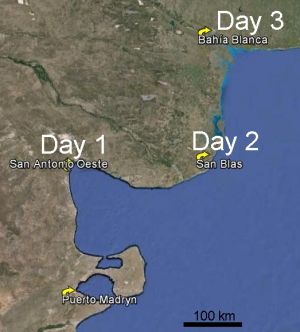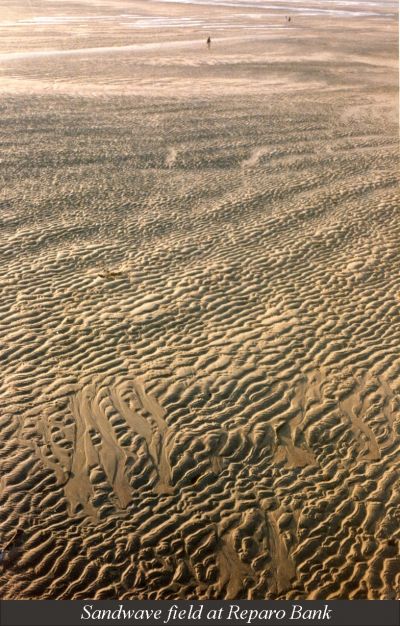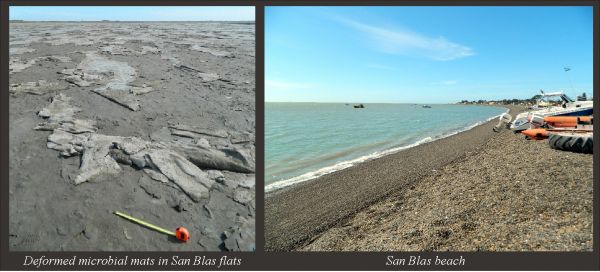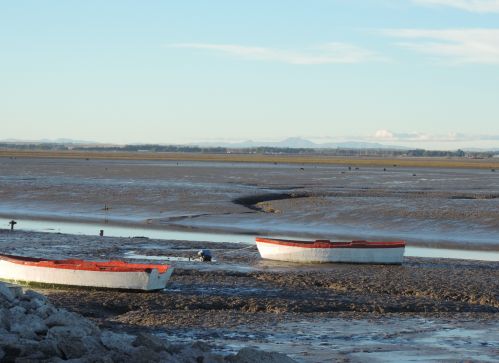(cancelled) Field Trip 4 - Bahía Blanca estuary
Postconference, 3 days (November 20th-22nd)
Departure: Puerto Madryn, November 20th at 8:00 a.m.
Return: Bahía Blanca, November 22nd evening.
Contact: cuadrado@criba.edu.ar
General description
The field trip comprises the visit to three modern environments, spanning 800 km along the Argentine coast, with the objective of recognizing present-day sedimentary processes. On the first stop, we will devote to a large intertidal dune field in San Antonio Oeste beach. The second day will find us at Paso Seco, in Bahía San Blas (northern Patagonia), visiting an ancient tidal channel corresponding to a temperate sabkha-type evaporitic environment. Several microbially-induced sedimentary structures are deformed by the interplay of sediment wetting and the prevailing strong winds on site. The Bahía Blanca estuary (Buenos Aires province) is a tide-dominated estuary with low river input where transgressive steps can be identified.

Day 1. November 20th. San Antonio Oeste beach.
Leader: Federico I. Isla
fisla@mdp.edu.ar
Instituto de Geologia de Costas y del Cuaternario- Instituto de Investigaciones Marinas y Costeras-CONICET
We will departure from Puerto Madryn to San Antonio beach to visit an intertidal dune field. Reparo Bank is a 10 km-long sand-wave field composed of sand and gravel. It is one of the outer banks (Reparo and Villarino) that limit the ebb channel of the San Antonio Bay. Both banks are composing the ebb tidal delta of the San Antonio Bay. The bay has a macrotidal regime that increases from 3 m at the inlet of San Matías Gulf to more than 7 m at San Antonio harbour complex during spring tides. The intertidal areas are characterised by a sand-wave field with oblique megaripples climbing the greater bedforms. We will travel to Viedma for lodging.

Day 2. November 21st. Bahía San Blas area.
Leaders: Diana Cuadrado1, Jerónimo Pan2
cuadrado@criba.edu.ar; jeronimopan@gmail.com
1. Instituto Argentino de Oceanografía-CONICET
2. Instituto de Investigaciones Marinas y Costeras-CONICET
After a 3-hour ride, we will arrive to Paso Seco, near the coastal town of Bahía San Blas; on the way we will take a gravel road (for nearly 50 km), with the opportunity of chance encounters with Patagonian wildlife (rheas, red foxes, armadillos). Upon arrival to Paso Seco, we will appreciate different environments within a short distance. First, an area characterized by vegetated coastal ridges composed by “rodados patagónicos” (Pliocene-Holocene fluvial gravels), leading to an ancient tidal channel which at present is largely colonized by thick microbial mats forming part of a natural laboratory for the study of microbial processes, provided many of these microbial structures are similar to those found in the geologic record. The prevalent processes involved in the deformation of these sedimentary structures comprise the interaction of sediment wetting and strong winds that determine the formation of folds and roll-up structures. Then, we will proceed to the town of Bahía San Blas, located on the shore of a deep channel (24 m depth) flanked with gravel sediments, a high-energy environment. At that point we will pass through a low energy coastal environment with low tidal vegetated plains. We will arrive to Bahía Blanca city at the evening.

Day 3. November 22nd. Bahía Blanca estuary.
Leaders: Diana Cuadrado, Paula Pratolongo, Eduardo A. Gómez, Gerardo M.E. Perillo
cuadrado@criba.edu.ar; ppratolongo@gmail.com; gmgomez@criba.edu.ar; gmeperillo@criba.edu.ar
Instituto Argentino de Oceanografía-CONICET

In the Bahía Blanca estuary we will recognize different stages of the Holocene marine transgression. The evidences of past changes in sea level in the coastal area of Bahía Blanca captured the attention of the young naturalist and geologist Charles Darwin, early during his famous voyage around the world, aboard HMS Beagle. Raised Holocene deposits in the Bahía Blanca estuary formed after the maximum Holocene Transgression (ca.6000 BP) during high energy periods identified as Transgressive Stages. In the northern shore of the main channel, we will visit a sequence of intermixed Holocene beach ridges and tidal-flat deposits, corresponding to high and low depositional energy periods. South of the main channel, in the western margin of the estuary, the gentler slope allows the clear distinction of at least two marine terraces of different elevations. We will see a shell-rich ridge at the base of a paleo-cliff, which would correspond to storm deposits indicating the inland limits of the marine transgression, at a 14C age of 5406 ± 227 BP. In this last unit, in a gradual transition to the active tidal mudflats and salt marshes, we will see a mosaic of halophytic shrubs, salt flats and former tidal cannels, presently unaffected by tides. This whole way depends on the condition of the road after rainy days.
Departure: Puerto Madryn, November 20th at 8:00 a.m.
Return: Bahía Blanca, November 22nd evening.
Transportation type: minibus
Degree of difficulty and weather: medium degree (some short walks around vehicle roads). Weather in November is template and it would probably be windy with temperatures around 20ºC during day. Intense sunshine throughout.
Suggested equipment: rubber boots or “water proof” sandals.
Number of participants: minimum 15 - maximum 20
Cost: Estimated cost about €450 per person; this includes 2 hotel nights with breakfast, 3 field lunch and 2 dinners in a restaurant, transportation costs and field guide.
Booking: your booking will be confirmed upon receipt a deposit of €100 per person.
